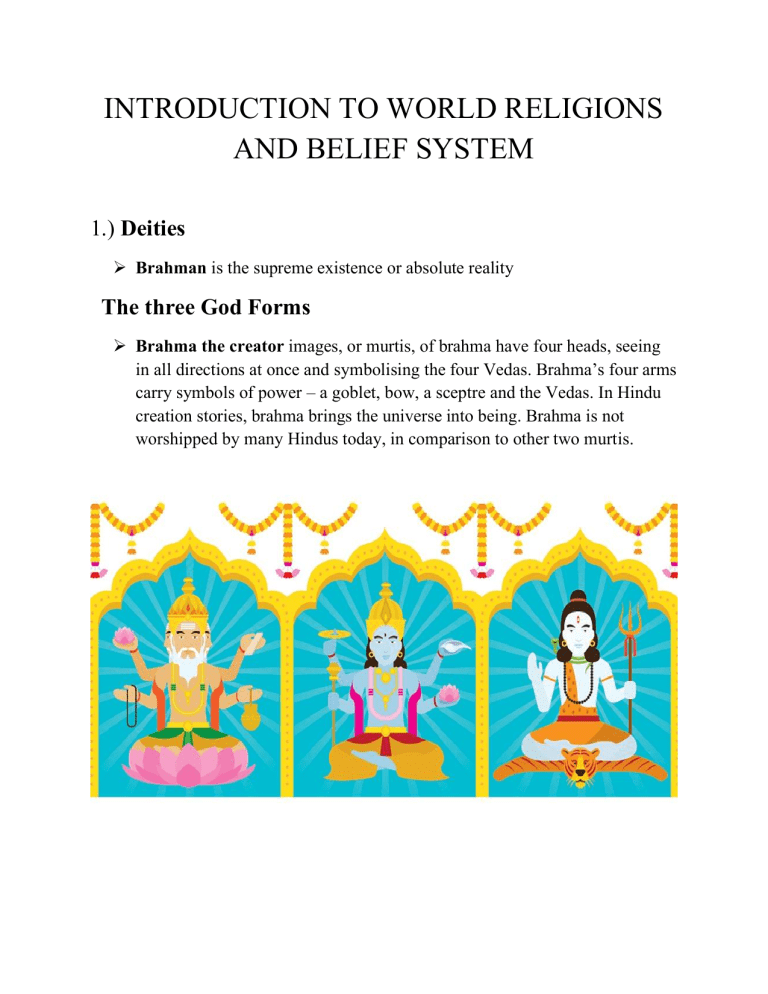
INTRODUCTION TO WORLD RELIGIONS AND BELIEF SYSTEM 1.) Deities ➢ Brahman is the supreme existence or absolute reality The three God Forms ➢ Brahma the creator images, or murtis, of brahma have four heads, seeing in all directions at once and symbolising the four Vedas. Brahma’s four arms carry symbols of power – a goblet, bow, a sceptre and the Vedas. In Hindu creation stories, brahma brings the universe into being. Brahma is not worshipped by many Hindus today, in comparison to other two murtis. ➢ Vishnu the preserver murtis of Vishnu express splendour and power. His four arms carry symbols of power – a discus, a lotus flower, a conch shell and a mace. Vishnu, god of light and enlightenment, has appeared on earth through avatars. Vishnu (and his avatar, including Krishna) are worshipped by many millions of Hindus today. ➢ Shiva the destroyer murtis of Shiva vary. He is often pictured dancing and with four arms. He holds a drum and a flame, and he points to his dancing feel with one hand and holds in the other hand pen, meaning “fear not”. His necklace of cobra is another sign of power. Shiva is worshipped by many millions of Hindus today. 2.) Yoga Yoga manifests itself as four major paths, namely Karma Yoga, Bhakti Yoga, Raja Yoga, and Jnana Yoga. Karma Yoga ➢ Karma yoga is one of the four classical schools of yoga alongside Jnana (knowledge or self-study), Bhakti (devotion) and Raja (meditation), each offering a path to moksha (spiritual liberation) and self-realization. ➢ Derived from the Sanskrit term for "action", karma is understood by both Hindu and Buddhist traditions to be the sum of a person’s deeds in past, present and future states of existence. In yoga, karma is known as the path of action, or selfless service towards others. ➢ The way of work ➢ Karma Yoga can be practiced anywhere, anytime where there is a desire to serve. It depends on the attitude, not the action. Bhakti Yoga ➢ The Sanskrit word bhakti comes from the root bhaj, which means “to adore or worship God.” Bhakti yoga has been called “love for love’s sake” and “union through love and devotion.” Bhakti yoga, like any other form of yoga, is a path to self-realization, to having an experience of oneness with everything. ➢ Bhakti Yoga is the branch of yoga that focuses on devotion and devotional practices. God is love and love is God. Bhakti yoga uses our fundamental emotional relationships and sublimates them into pure, selfless, divine love. There are 9 traditional ways to sublimate emotions to devotion, overcome egoism, and realize God according to the teachings of Bhakti Yoga. ➢ The way of love ➢ It can be practiced in many ways, praying, chanting, japa (repeating a mantra or name of the Divine), and by participating in ceremonies and rituals. Jnana Yoga ➢ Jnana, (Sanskrit: “knowledge”) in Hindu philosophy, a word with a range of meanings focusing on a cognitive event that proves not to be mistaken. In the religious realm it especially designates the sort of knowledge that is a total experience of its object, particularly the supreme being or reality. ➢ The fundamental goal of Jnana yoga is to become liberated from the illusionary world of maya (self-limiting thoughts and perceptions) and to achieve the union of the inner Self (Atman) with the oneness of all life (Brahman). ➢ The way of knowledge ➢ The path of knowledge, wisdom, introspection, and compilation. ➢ It is practiced through: • Sravanam, which literally means listening. • Mananam, which literally means contemplating or remunerating facts in your head. • Nididhyasana, which literally means meditating. Raja Yoga ➢ In Sanskrit, the word raja means "king," or one who has achieved self-mastery, while the word yoga itself means "union" or "connection." Having originated as early as 300 B.C., it was practiced by actual kings, most notably the eleventh century King Bhoja, who wrote an extensive and influential commentary on it. ➢ In essence, Raja yoga is the yoga of mind and body control, with a focus on meditation and energetics. It encompasses teachings from all the different paths, and it is from Raja yoga that hatha yoga and modern asana practice developed. ➢ The way of meditation ➢ In the practiced of Raja Yoga, the mind is systematically analysed and various techniques are applied to bring it under control. This process turns the physical and mental energy into spiritual energy. 3.) Summary The Different Religions JUDAISM ➢ Judaism, monotheistic religion developed among the ancient Hebrews. Judaism is characterized by a belief in one transcendent God who revealed himself to Abraham, Moses, and the Hebrew prophets and by a religious life in accordance with Scriptures and rabbinic traditions. CHRISTIANITY ➢ Christians are monotheistic, i.e., they believe there's only one God, and he created the heavens and the earth. ... The essence of Christianity revolves around the life, death and Christian beliefs on the resurrection of Jesus. Christians believe God sent his son Jesus, the messiah, to save the world. ISLAM ➢ The word “Islam” means “submission to the will of God.” Followers of Islam are called Muslims. Muslims are monotheistic and worship one, all-knowing God, who in Arabic is known as Allah. Followers of Islam aim to live a life of complete submission to Allah. ... The Quran (or Koran) is the major holy text of Islam. HINDUISM ➢ Hinduism is more than a religion. It is a culture, a way of life, and a code of behavior. This is reflected in a term Indians use to describe the Hindu religion: Sanatana Dharma, which means eternal faith, or the eternal way things are (truth). ... Unlike Buddhism, Jainism, or Sikhism, Hinduism has no historical founder. BUDDHISM ➢ The word Buddha means “enlightened.” The path to enlightenment is attained by utilizing morality, meditation and wisdom. ... Some scholars don't recognize Buddhism as an organized religion, but rather, a “way of life” or a “spiritual tradition.” Buddhism encourages its people to avoid selfindulgence but also self-denial. CONFUCIANISM ➢ Confucianism is an ancient Chinese belief system, which focuses on the importance of personal ethics and morality. ... Confucianism is a philosophy and belief system from ancient China, which laid the foundation for much of Chinese culture. Confucius was a philosopher and teacher who lived from 551 to 479 B.C.E. TAOISM ➢ Taoism (also spelled Daoism) is a religion and a philosophy from ancient China that has influenced folk and national belief. ... wrote the main book of Taoism, the Tao Te Ching. Taoism holds that humans and animals should live in balance with the Tao, or the universe. SHINTOISM ➢ Shinto is a religion which originated in Japan. Classified as an East Asian religion by scholars of religion, its practitioners often regard it as Japan's indigenous religion and as a nature religion. Scholars sometimes call its practitioners Shintoists, although adherents rarely use that term themselves. PERSONAL REFLECTION It is our choice whether or not to follow a religion. We have the right to select the religion we choose to follow. Since a religion has its beliefs, it has inspired us in various ways and has an impact on our daily lives. It had brought us transformation and given us a path to follow in life. Our culture and manner of life were affected by religious ideas. It provides moral principles, social change, social peace, and positive life goals and a sense of belonging to society. Religion creates a sense of belonging and gives people a sense of purpose in life.Belonging to a particular religion, as a Christian, has offered me and my family comfort and comfort in our relationship with God. Religion, in my opinion, creates a sense of hope and optimism. Religion, you see, is what brought us together. It has brought people together in a culture and shared their ideas and views. As a result, everyone of us should show love and respect to other religions, as they, too, have their own set of beliefs and ideals.



